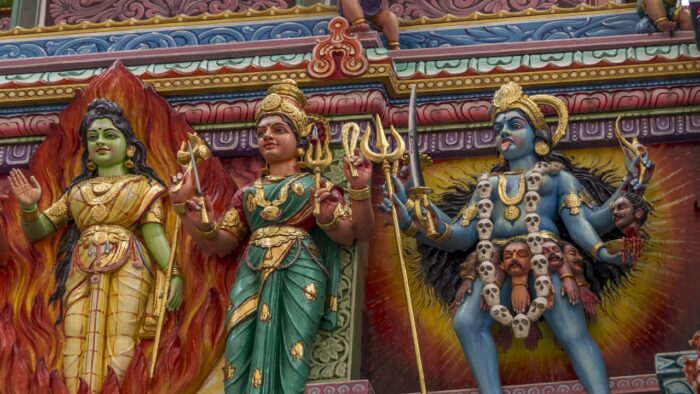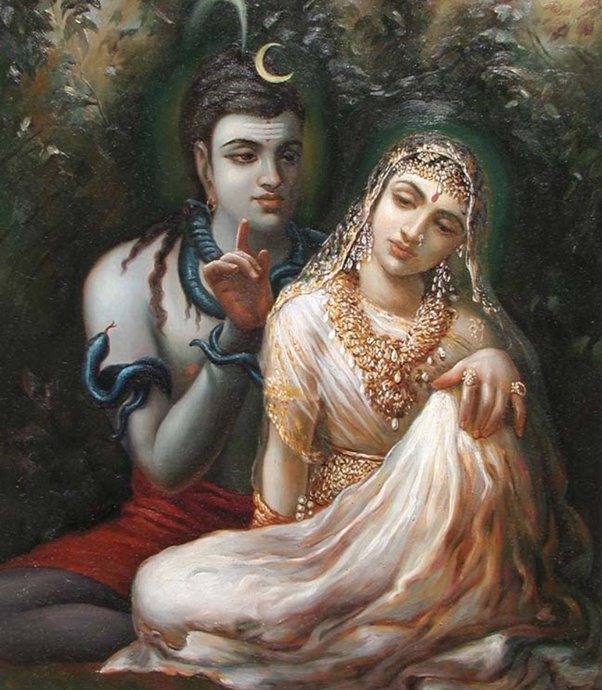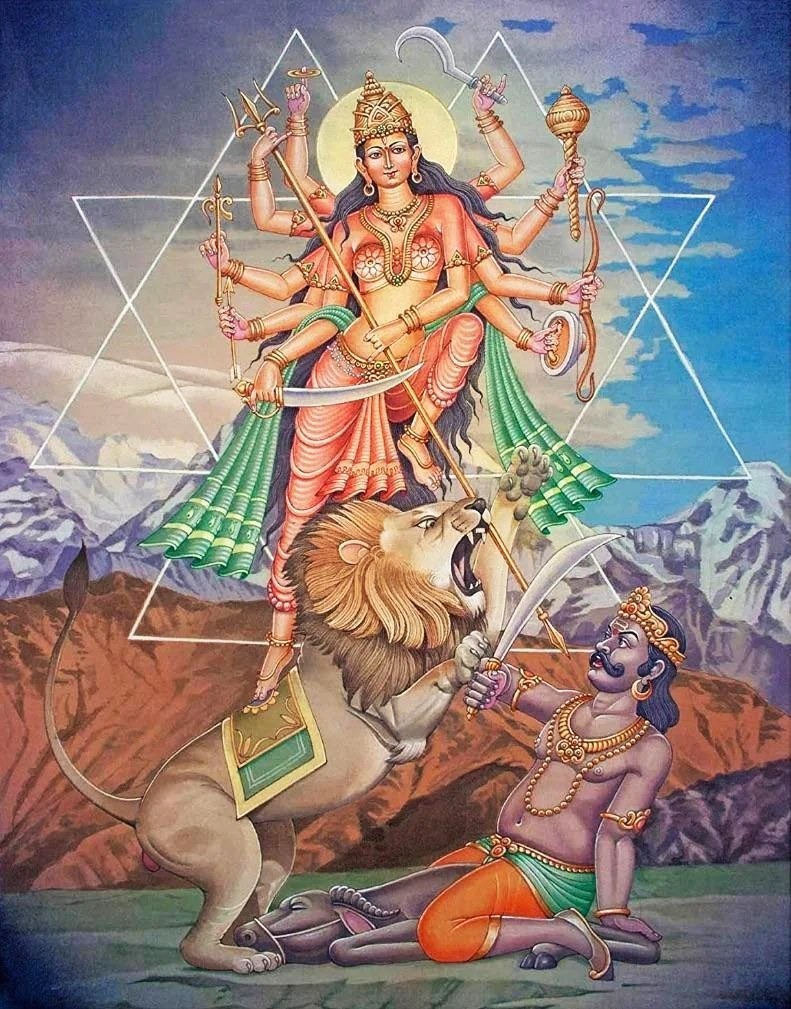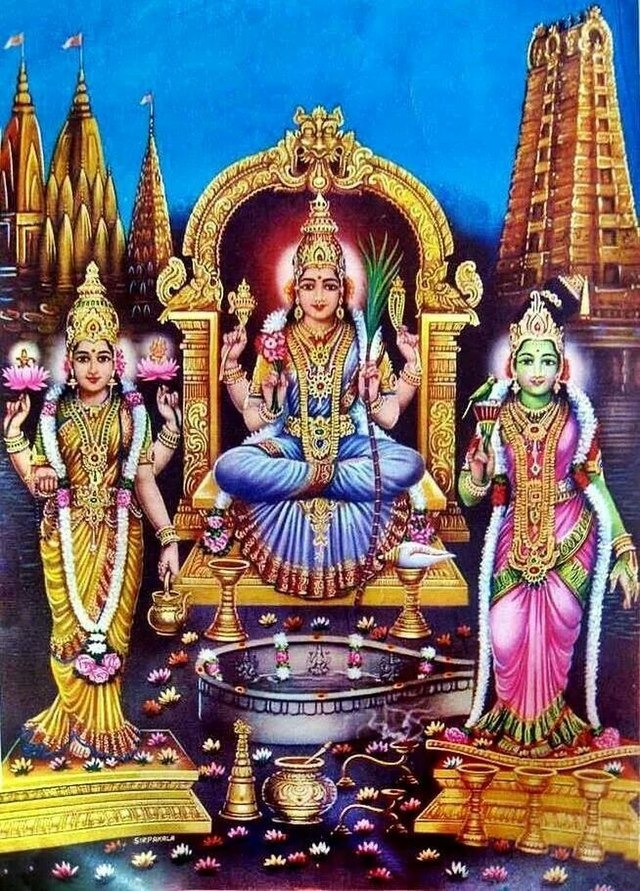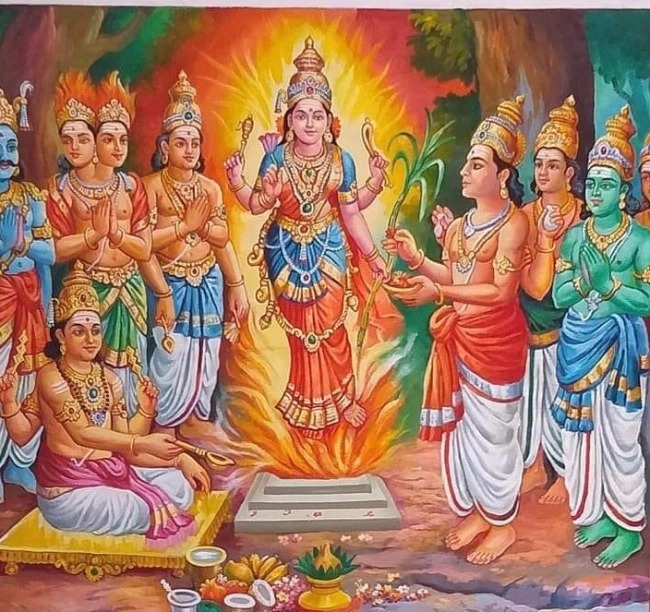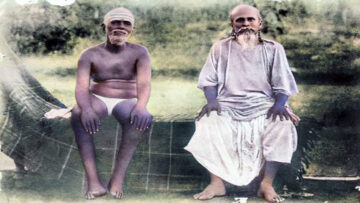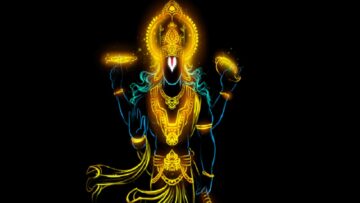Introduction
Reverence of the Sacred Feminine in Indic thought finds its most systematised expression in Śākta traditions, which are conceptually contiguous and coeval with Śaiva traditions. While Śākta theology shares with gynocentric theology elsewhere an emphasis on the maternal aspect of the divine and a concomitant sacralising of fertility in the living world, it shares with its coeval Veda-influenced and Āgama-based theologies the identification of the Supreme Being with a Consciousness that is both immanent in all living beings and transcends the cosmos itself. Terms that are standard throughout the Veda and Āgama corpus for consciousness as a transcendental attribute of the Supreme Being (Cit), and as an animating power immanent in living beings (Citi), also refer to manifestations of the Supreme Being (non-different from the Sacred Feminine called Devī or Śakti) in Śākta texts. These terms also feature centrally in the conceptual frameworks of the philosophical schools of Vedānta and Yoga, which are both externally discernible and internally acknowledged influences on the systematisation of Śākta thought. The goals of this study are to summarize Śākta conceptions of the presence of Śakti as Cit and Citi, and examine possible correspondences in the treatment of Cit and Citi in foundational Vedānta and Yoga texts.
(Figure 1: Credit: Pinterest – Shiva Paravati Samvaad)
Methods
The primary sources chiefly used here to establish the centrality of the concepts of Cit and Citi in Śākta thought are prominent in contemporary popular Śakti veneration as well, namely, the Lalitā-sahasranāma of the Brahmāṇḍa-purāṇa and the Devī Māhātmya (specifically, the Tantrokta Devī-sūkta) of the Mārkaṇḍeya-purāṇa. The text referred to here as a representative of the broader Tantra corpus, is the Pratyabhijñāhṛdaya, a magisterial summary in the sūtra format of the tenets of the Pratyabhijñā or Trika Śaiva school which has shared Tantra-based foundations with Śākta schools. It is the primary sūtra texts of Vedānta and Yoga, namely the Prasthānatrayī (consisting of the principal Upaniṣad-s, Brahmasūtra-s and Bhagavadgītā) and the Pātañjala Yogasūtra that are chiefly referred to here to trace the concepts of Cit and Citi in these schools.
A resource employed to assist the survey of the Lalitā-sahasranāma for Cit-related epithets is “Lalitāsahasranāma with Bhāskararāya’s Commentary” translated into English by R Ananthakrishna Sastry. Additional sources of academic reference here on the evolution and philosophical positions of the Śākta and Śaiva schools, which copiously cite both Tantra and Āgama texts as well as texts of Vedānta and Yoga, are “Śakti and Śākta” by John Woodroffe and “Śaiva Siddhānta in Philosophical Perspective” by K Sivaraman.
(Figure 2: Credit: Hinducosmos – Dashabhuja Durga – who emerged from the collective energy of all Goddesses as an embodiment of Shakti or divine feminine power)
Review Summary
Consciousness, as an indispensable property of living beings or as an integral attribute of the Supreme Being, has been a subject of inquiry as well as contemplation with varying degrees of emphasis across darśana-s that accept a Supreme Being, including those that belong to the Ṣaḍdarśana schools of philosophy and Āgama-based schools centred on particular deities. In both groups of schools, the primary term of reference in such inquiry is Cit. Cit is both etymologically and conceptually at the root of other significant terms of references such as Citi, Cetanā and Citta, all of which refer either to derivative or essential aspects of that which is postulated as indispensable to conscious experience and distinct from any object of experience. It is around occurrences from this family of terms that the literature review of Śākta and Ṣaḍdarśana sources here is organized.
Cit and Citi in Śākta frameworks
Śakti, for whom the Śākta system is named, is by definition Cit-śakti in the theological schemes of Śākta as well as Śaiva systems. The effective synonymity of Śakti with Cit-śakti shows how Cit is understood as an identity, and not just an attribute, of the Śakti. Cit-śakti occurs as an epithet in the canonical listing of names of the primary deity of a major Śākta denomination, namely the Śrīkula, in the Lalitā-sahasranāma of the Brahmāṇḍa-purāṇa. There is a significant instance of occurrence in the Mārkaṇḍeya-purāṇa of Citi in the sense of the sentient principle in living beings. However, it is in the Pratyabhijñā Śaiva system that Citi is the standard designation of an elaborately characterized and exalted entity that is also designated by Cit-śakti in allied systems. In this section, the Purāṇa references are tangibly related to contemporary Śākta devotion, whereas a representative example of a Śākta theoretical framework is supplied by the Pratyabhijñāhṛdaya.
Purāṇa sources
The English translation of epithets from the Lalitāsahasranāma shown in parentheses here are as given by R Ananthakrishna Sastry.
Cit-śakti and Citi appear by themselves as epithets of the Sacred Feminine in names 416 and 364 of the Lalitāsahasranāma. The commentator Bhāskararāya give meanings at both cosmic and individual levels of Cit attested in Śākta texts, as a quality opposed to ignorance (avidyā), the power causative of the Universe, and the will to live in living beings. Similarly attested meanings given for Cit-śakti are the power to remove avidyā and the power in the absence of which a living being is a corpse. Names declaring Cit to be the very form and substance of the Goddess are Cinmayī (“Consciousness itself”), Cidekarasarūpiṇī (“The one essence of intelligence”), Pratyakcitīrūpā (“Inner consciousness”) and Cetanārūpā (“In the form of Consciousness”) occurring as names 251, 364, 367 and 417. While this listing of epithets occurs in the Brahmāṇḍa-purāṇa, the Bhāskararāya commentary supplies justifications for the names such as Cit-śakti and Cetanārūpā by citing from the Devī-bhāgavata-purāṇa, thus demonstrating a measure of consistency in the characterization of Devī or Śakti across the purāṇa corpus. A shared implication of the names just listed above can be seen as what finds explicit declaration in the conclusion of the Tantrokta Devīsūkta in the Devī Māhātmya that Devī pervades the cosmos and all its inhabitants in the form of Citi.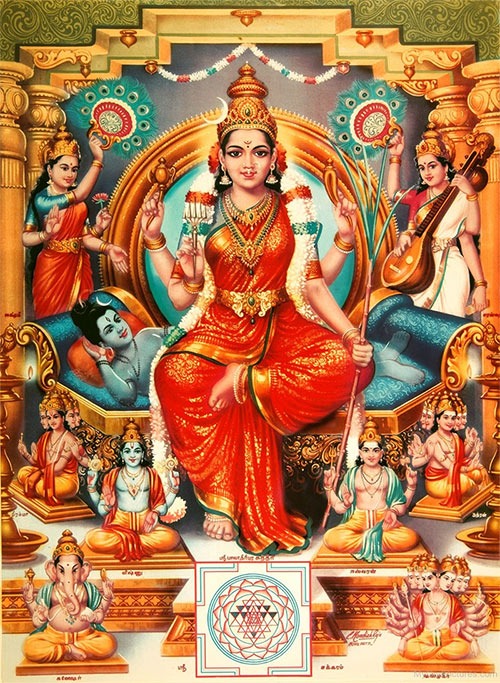
(Figure 3: Credit: RudrakshaRatna – Lalita Maha Tripurasundari)
Notably, a comparable number of epithets based exclusively on Cit declaring Consciousness as the form of the deity, is not seen in other Sahasranāma compositions of comparable prevalence, such as the Viṣṇusahasranāma of the Mahābhārata and the Śivasahasranāma-s of the Mahābhārata and Śivapurāṇa. Arguably, the identification of Śakti with Cit as reflected in the deity’s names held sacred for worship, is on a larger scale and with greater emphasis than that of other principal deities.
Some names incorporating Cit in the Lalitāsahasranāma occur in close proximity to names primarily incorporating either Sat or Ānanda, or themselves also simultaneously incorporate the other elements of the Sat-Cit-Ānanda triad. For instance, Cinmayī (“Consciousness itself”) is immediately followed by Paramānandā (“Supreme Bliss”) in names 251 and 252, and Citkalā (“Consciousness encased in the mind because it is a small part of that consciousness which has no vehicle i.e., Brahman”) is immediately followed by Ānandakalikā (“Germ of bliss” or “Bud of the Ānanda sheath”) in names 728 and 729. The deity is simultaneously identified with Brahman that is interchangeable with Sat-Cit-Ānanda, explicitly by the epithet Saccidānandarūpiṇī (“Existence, Consciousness and Bliss”) occurring as name 700, and through implication via epithets such as Pañcakośāntarasthitā (“Residing in the five sheaths”), Daharākāśarūpiṇī (“The subtle ether in the heart”) and Bhūmarūpā (“Aggregate of all existing things”) in names 428, 609 and 666. In Satyajñānānandarūpā (“Truth, Wisdom and Bliss”) occurring as name 792, the place of Cit is taken by Jñānam, which is declared as the very form of the deity in Jñānavigrahā (“Whose body is knowledge”) and Jñānajñeyasvarūpiṇī (“Knowledge and knowing”) occurring as names 644 and 981.
Cit-śakti is also the implied referent in some epithets that do not literally incorporate “Cit”. The implication can be via negation such as in the epithet Nāmarūpavivarjitā (“Transcending name and form”) occurring as name 300, which the gloss by Bhāskararāya infers as synonymous with the Cit-śakti that alone remains when names and forms are eliminated. Other instances where Cit-śakti is implied via negation are Adṛśyā (“Invisible”), Dṛśyarahitā (“Transcending the visible”), Vedyavarjitā (“Transcending the knowable”) and Deśakālāparicchinnā (“Unlimited by space and time”) in names 649, 650, 652 and 701. The implication can also be via affirmative enumeration of operative aspects of Cit-śakti like in Icchāśaktijñānaśaktikriyāśaktisvarūpiṇī (“The energies of desire, wisdom and action”) occurring as name 658. Finally, the implication can also be by association, like in the epithet Śivā occurring as name 53, which declares the deity as being of the nature of the nature of Śiva to whose nature Cit-śakti is integral.
(Figure 4: Credit: Facebook – Vishalakshi, Kamakshi and Meenakshi as Icchāśaktijñānaśaktikriyāśaktisvarūpiṇī; “the energies of desire, wisdom and action”)
While the Lalitāsahasranāma extensively associates Consciousness with the deity, the world of Matter is not dissociated from the deity either, as can be seen in how Jaḍaśakti (“The energy of the inanimate creation”) and Jaḍātmikā (“The objective world”) occurring as names 418 and 419 immediately follow the names Cit-śakti and Cetanārūpā. The sovereignty of the deity over all divisions of creation is reiterated in epithets like Vyaktāvyaktasvarūpiṇī (“In the form of manifested and unmanifested”), Vidyāvidyāsvarūpiṇī (“In the form of knowledge and ignorance”) and Sadasadrūpadhāriṇī (“The foundation of being and non-being”) occurring as names 399, 402 and 661. While Cit itself in one of its multiple meanings is identified with the cause of all creation, the entities posited as the cause of all creation by both the Sāṃkhya school, namely Mūlaprakṛti (“Primary cause”), and the Vedānta school, namely Māyā (“Illusion”) appear declared as aspects of the deity in names 397 and 716.
A secondary meaning of “Cit” (more frequently conveyed by its closely related word “Citi”) is “assemblage”, which has both an inner psychological dimension as the aggregate of all conscious thought, and an outer ritual dimension as the altar of yajña. A name which both incorporates Cit and evokes yajña through sacrificial imagery, occurring as early as the fourth position of the Lalitāsahasranāma is Cid-agni-kuṇḍa-sambhūtā (“Who was born from the altar of the fire of consciousness”). The deity is also described as a recipient of ritual worship that is sublimated from material offerings to pure consciousness, via the epithets Caitanyārghyasamārādhyā (“Worshipped with consciousness as the oblation”) and Caitanyakusumapriyā (“Fond of the Caitanya-flower”) in names 918 and 919. A citation of tremendous ritual significance from the Devī-bhāgavata-purāṇa appears in Bhāskararāya’s gloss for the epithet Cetanārūpā, where Cetanā is identified with the effulgence that is contemplated upon in the Gāyatrī Mantra.
(Figure: 5: Credit: Facebook – Lalita Avirbhava out of Cid-agni-kuṇḍa)
Besides names significant to sacrificial and devotional worship, the Lalitāsahasranāma names having significance to practice of Aṣṭāṅga Yoga and Haṭha Yoga, specifically to the states of consciousness attainable thereby. Pratiṣṭhā (“Foundation”) occurring as name 829, occurs as a salient term in the concluding sūtra of the Pātañjala Yogasūtra which declares the summum bonum of all Yoga discipline as the reinstatement in the Yogin’s true nature (svarūpapratiṣṭhā), which itself also has the name Citi-śakti. Cakrarājarathārūḍhasarvāyudhapariṣkṛtā (“Seated in the chariot named Cakrarāja, armed with all weapons”) occurring as name 68, is given a meaning in Bhāskararāya’s commentary as the state of lordship over all bodily Cakra-s attained by Yogin upon the reinstatement of his own Cit-śakti.
Tantra and Āgama sources
A brief summary of the conceptual treatments of Cit-śakti along with equivalent and related categories is presented here from two closely related Āgama-based Śaiva traditions, namely the SaiddhāntikaŚaiva (or ŚaivaSiddhānta) and Trika Śaiva (or PratyabhijñāŚaiva) traditions. This will supply background and context for the presentation of Citi in a specific text summarizing Trika Śaiva doctrine, namely the Pratyabhijñāhṛdaya.
In both the Saiddhāntika and TrikaŚaiva schools, the Universe is categorized hierarchically into 36 tattva-s or levels of reality, of which the lowest are the five gross elements and the highest two are Śiva and Śakti, with Māyā occurring intermediately. The soteriological programme in both schools is realization of progressively higher tattva-s with the preceding tattva-s as means, culminating in the realization of Śakti and Śiva tattva-s.
In the scheme of ŚaivaSiddhānta, where Śiva is the Supreme Being, Śakti is posited as the ultimate modality by which Śiva relates to the world and other beings. Śakti operates as the “Will” of the Supreme Being to manifest other beings and become manifest to these beings. This Will in its primal and unactualized state is called Ādiśakti due to which the world and all beings are held unmanifest, and in its variegated and actualized form comprises the icchā, jñāna and kriyāśakti-s of Śiva due to which the world is manifested and beings can receive revelation. The relation between Śiva and Śakti in this scheme is homologous to the relation between Cit and Cit-śakti, where Cit is the nature of Śiva like it is the nature of the Sun to reveal itself, and Cit-śakti is the nature of Śakti like it is the nature of the Sun to be able to reveal other objects. Cit-śakti is thus also the means of self-revelation for an aspirant, and thus in the context of beings other than Śiva is referred to as Ātma-cit-śakti. Ātma-cit-śakti is to an aspirant what Śakti is to Śiva, except that the former is realized only when ignorance veiling the aspirant is lifted whereas the latter refers to a permanent state of illumination eternally free from ignorance. Reinstatement of Ātma-cit-śakti is the soteriological goal of ŚaivaSiddhānta.
In the Trika Śaiva scheme too, Śiva is the Supreme Being related to Śakti like Cit is to Cit-śakti, and this relation is expressed in terminology extensively employed in this system via the terms Prakāśa and Vimarśa. Prakāśa, which is the nature of Śiva, is like the nature of the Sun to manifest itself, as Cit is in ŚaivaSiddhānta. Vimarśa, which is the nature of Śakti, is like the power of the Sun to reveal other objects, as Cit-śakti is in ŚaivaSiddhānta. In a physical analogy illustrating their mutual relation, Prakāśa is likened to light, and Vimarśa to light’s own modifications like reflection. In a closely related analogy, Prakāśa or Cit is likened to Space, and Vimarśa or Cit-śakti (inclusive of Māyā-śakti) to stirrings or “vibrations” in it. Consistent with this understanding, Vimarśa in this scheme also stands for the phenomenon of speech and Prakāśa for the intangible meaning of speech. More specifically, the quality of Vimarśa is attributed to letters (varṇa-s), mantra-s and words (pada-s); whereas the quality of Prakāśa is correspondingly attributed to parts (kalā-s), categories or realities (tattva-s, which are numbered at 36 in a descending hierarchy from Sadāśiva to the gross Earth element) and worlds (bhuvana-s). The soteriological goal of the Trika Śaiva school is realization of the highest tattva (which is of the quality of Prakāśa and identified with Śiva), for which the means is Vimarśa-śakti, especially as expressed in the form of mantra-s.
(Figure 6: Credit: Pinterest – Prakāśa-śakti and Vimarśa-śakti)
The Pratyabhijñāhṛdaya is a brief sūtra text summarizing Trika Śaiva tenets in 20 aphorisms. The text is effectively a treatise on Citi, which is the text’s designation of the foremost Śakti tattva. Citi is declared as the sovereign and self-sufficient cause of the world (Sūtra 01 and 02), present in a willingly constrained manner in each being rendering them conscious (Sūtra 04) and simultaneously present in the form of all that living beings can apprehend and also their means of apprehending anything i.e., Citta (Sūtra 05). The cause of bondage in a living being whose original nature is that of Cit is the constraining of Citi (Sūtra 09), which is overcome by means of meditative introspection leading to progressive realization of higher tattva-s leading back to the unconstrained Śakti that is verily Citi (Sūtra 10-13). In an evocative metaphor reminiscent of the Lalitāsahasranāma epithet of Cidagnikuṇḍasambhūtā, the constrained Citi is described as fire which is obscured by ignorance during its undeveloped stage, and consuming objects of experience as if they were fuel during its (re-) developing stages (Sūtra 14). Overcoming of bondage through the progressive release of the constraint on Citi imparts experience of unity with all of creation (Sūtra 15), jīvanmukti or liberation even while alive in a physical body (Sūtra 15) and ultimately, realization of the Śiva-tattva (Sūtra 20). Notably, disciplines and attainments of Yoga feature prominently in the description of the means for reinstatement of Citi, such as mastery over prāṇa (Sūtra 18) and accomplishment of samādhi (Sūtra 19).
Cit and Citi in Ṣaḍdarśana frameworks
Of the six schools constituting the Ṣaḍdarśana, three schools which acknowledge a Supreme Being designated as Īśvara are Vedānta, Yoga and Nyāya. A distinct notion of a Sacred Feminine does not appear in the minimal characterization of the Supreme Being in these schools. However, they can yet potentially lend themselves to an examination of how Cit is treated as an attribute of the Supreme Being. In the Vedānta system, Cit is integral to the characterization of the Supreme Being, and also the highest state attainable by an aspirant, as Sat-Cit-Ānanda which is commonly translated as Existence-Consciousness-Bliss. The Yoga system in its characterization the state closest to the Supreme Being attainable by an aspirant, includes only Sat and Cit, whereas the Nyāya system includes only Sat. Therefore, it is only those schools from the Ṣaḍdarśana where Cit features centrally in the characterization of the highest Being and highest state of being, namely Vedānta and Yoga, that are considered in this study. Some discussion of the Sāṃkhya School is incorporated within that of Vedānta and Yoga noting that these assume Sāṃkhya cosmology to a large extent, though with significant modifications. In this section, the Prasthānatraya references mainly concern Cit as integral to the realization of Sat-Cit-Ānanda, and the Yogasūtra references concern requisites to the realization of Cit in the forms of refinement of Citta and attainment of Citi-śakti.
Vedānta sources
The characterization of Brahman, the Supreme Being in the Vedānta system, as Sat-Cit-Ānanda is based on and consistent with descriptions of Brahman in the Prasthānatraya textual core of Vedānta. The Prasthānatraya texts do not feature a feminine conception of Brahman (which subsumes Cit in its nature as Sat-cit-ānanda, and has a status like Puruṣa’s in Sāṃkhya and Yoga) like they do for Māyā (which operates similarly to Sāṃkhya’s Prakṛti). Māyā in Vedānta is conceptualized as a potency of Brahman like in the Bhagavadgītā (07:14, 09:08).
The Śvetāśvatara Upaniṣad, which is part of the broader Vedānta corpus though not universally acknowledged as a principal Upaniṣad, contains references similar to Prakṛti as characterized in Sāṃkhya texts (1.8-10, 4.5, 4.10, 5.2, 6.10) as well as to Māyā as characterized in other Vedānta texts (3.1-2, 4.9-10) in its account of how the Supreme Puruṣa relates to the world. Whereas these references contain instances which when taken by themselves show Prakṛti as having a distinct existence with respect to Puruṣa, they do not contain any showing Māyā having an existence independent of the Supreme Being. It must be noted here that even in the instances where Prakṛti is shown as distinct and as symbolically feminine, it is not accorded a sacred status comparable to that of the Supreme Puruṣa.
Whereas the Sāṃkhya position is that Prakṛti (also designated as Pradhāna) and not Puruṣa that is the material and efficient cause of creation, the theoretical position of Vedānta does not correspondingly accord the same role to Māyā with respect to creation. A section in the Brahmasūtra (1.1.5-11) is dedicated to a refutation of Pradhāna as the material and efficient cause of creation, and establishes Brahman itself as both.
It is instructive here to compare the Advaita Vedānta and Śaiva Siddhānta positions on the ultimate cause of creation, to gain a clear appreciation of how Cit emerges as a distinctly exalted category only in the latter even though it is integral to the nature of the Supreme Being in the former. In Advaita Vedānta, the potency of Māyā, or Māyā-śakti, is only an upādhi or adjunct of Brahman leading to the production of the world while remaining as itself and neither modifying nor variegating, like in the rope-snake analogy where the rope “produces” a snake while still being a rope. There is no role specific to the Cit aspect of Brahman in this account. In Śaiva Siddhānta, the Cit aspect of the Supreme Being is interpreted as this Being’s “Will” to create the world, which is what operates as Māyā-śakti. Māyā-śakti in this account is not adjunct but integral to the Supreme Being, and the manifestation of the world is the “diversification” of the absolute unity of the Supreme Being via its own Māyā-śakti.
It is pertinent to note here that conceptions of the Sacred Feminine in Śākta traditions (with the Lalitāsahasranāma as a case in point here) are not limited to treating Śakti as equivalent to an aspect of Brahman like Cit, but can include treating Śakti as equivalent to Brahman itself. A consequence of the minimal conception of Brahman in Vedānta texts as transcending anthropomorphic (or gynomorphic) categorizations, is that it is no less compatible with the veneration of the Supreme Being with feminine attributes than with masculine ones.
Yoga sources
The final goal of Yoga as defined apophatically in the opening of the Pātañjala Yogasūtra is the cessation of distortions of Citta (Sūtra 1.2). The final goal of Yoga is also defined cataphatically in final sūtra as the attainment of Citi-śakti (4.34) which is defined as abidance in one’s true nature. Both formulations are ultimately equivalent, considering how an undistorted state of Citta is the condition of realizing and abiding in one’s true nature (Sūtra 1.3). The Yogasūtra does not provide a formal definition of Citta, but characterizes the distortions of Citta (Sūtra-s 1.4-11) and provides means for their cessation (Sūtra-s 1.10, 2.01, 1.29). The Citta during this process of progressive cessation of distortions is likened to a flawless transparent gem capable of undistorted reflection of any object of consciousness (Sūtra 1.41). The Yogasūtra describes a variety of states of meditative absorption or samādhi (Sūtra-s 1.46, 1.51, 4.29) along with special powers (Sūtra-s 3.11-36) that are said to be attainable in the course towards the final goal of Citi-śakti.
While the occurrence of Citi-śakti as a term in the Yogasūtra is in a significant and memorable position, no elaborate characterization, let alone a treatment of the concept as symbolically feminine, appears therein given the brevity of the text. However, the correspondence of Citi-śakti here with the better characterised and conspicuously symbolically feminine Citi-śakti of Śaiva traditions, is not limited to this isolated literal occurrence. The process leading to the realization of Citi-śakti with the Citta as the initial basis, which is laid out in the Yogasūtra overlaps significantly with the template for overcoming the constraining of Citi in the Pratyabhijñāhṛdaya. For instance, the image in the Pratyabhijñāhṛdaya of Citi in its constrained stage as a fire fuelled by objects of experience in the process of recovering its pristine state, can be seen as an illustration of the method described in the Yogasūtra of supplying the Citta with a variety of suitable objects of sustained and intense experience as a means of making the Citta recover its pristine state (Sūtra-s 1.32-39). One of the powers mentioned in the Yogasūtra, a variety of apprehension called Pratibhā (Sūtra-s 3.33, 3.36) is also a well-elaborated concept in the Pratyabhijñā Śaiva tradition.
The re-establishment of Citi-śakti in the original state, which is the ultimate state of Yoga, is also homologous to the ultimate state of the Śaiddhāntika and Trika Śaiva, both in the individual aspirant’s sense of realizing the Śakti and Śivatattva-s and the cosmic sense of the world-causing Cit-śakti subsiding into its primal form.
Discussion
This study refers only to those Śākta sources whose perusal by the uninitiated is not traditionally proscribed. Thus, this study is limited to identifying associations across darśana-s in conception and status of categories approximately corresponding to modern notions of Consciousness, and does not cover the esoteric significance of those categories.
In contemporary popular introductory discourse on Indian schools of philosophy, the Sāṃkhya categories of Puruṣa and Prakṛti are presented as symbolically masculine and feminine respectively, and simultaneously as representing the subject and object of consciousness respectively. Furthermore, Prakṛti in such discourse that is often conducted in English tends to be treated as synonymous with Nature conceived as distinct from Consciousness. Such an association of Consciousness with Puruṣa, and consequently its dissociation from Prakṛti, is liable to prompt a faulty generalization that the Sacred Feminine in Indic thought is even its ultimate expression at best equated to the ultimate object of Consciousness, but not to the ultimate Consciousness itself. The Śākta conceptions of Cit and Citi as surveyed in this study themselves constitute a demonstration of a major instance in Indic thought where the Sacred Feminine is neither circumscribed to Nature nor separated from Consciousness.
“Cit” is grammatically a feminine noun in Sanskrit, as are the etymologically related “Citi” and “Cetanā”. The association of the Sacred Feminine with the grammatically feminine Cit, as reckoned via sacred names characterizing the deity in ritual spheres as well as the popular imagination, is more conspicuous and extensive than associations of Cit with deities other than the Sacred Feminine. Also, the association with the Sacred Feminine of the grammatically feminine Cit is by similar standards more pronounced than with Sat or with Ānanda, which are by default grammatically masculine or neuter. There is no claim here of a theoretical principle or strict rule underlying these associations, and these observations concerning grammatical gender of aspects of deities as made here are exclusively empirical. Instances of faculties with grammatically feminine names that can be seen deified with feminine attributes in sūkta-s of the Ṛgveda include Vāk and Medhā. While Cit does not receive such treatment explicitly in the Ṛgveda, a sūkta dedicated to Vāk (Ṛgveda 10.125) is pervaded by the idea of an indwelling animating potency in the manner that Cit is described in the Purāṇa and Tantra corpus. The Mārkaṇḍeya-purāṇa’s Tantrokta Devīsūkta which begins and concludes with homage to Devī as being all-pervading in the form of Cetanā and Citi respectively, is composed as a series of salutations to Devī declared to pervade all beings in forms which have grammatically feminine names, such as buddhi, śakti, śānti, vṛtti and smṛti.
While this study has relied chiefly on textual sources to establish the intimate association of Cit with Devī, the association can also be seen reiterated in the visual grammar of Śaiva iconography. In the Umāmaheśvara representation that is particularly pervasive in Pāla era sculpture, Umā is shown holding up a mirror representing vimarśa-śakti (which is fundamentally Cit in its distinct and operative aspect) to Her own form as Maheśvara that represents prakāśa (which is fundamentally Cit in its undifferentiated and original aspect). In Śaivāgama temple worship, the Somāskanda representation, where Śiva appears seated with Umā and Skanda, has a prominent place and is the subject of extensive symbolic interpretation by traditional and popular expositors. In one symbolic interpretation, Somāskanda is an embodiment of yajña with Śiva as the officiant, Umā as the vedī or agnikuṇḍa and Skanda as the arising fire of sacrifice itself. In another symbolic interpretation, Śiva, Umā and Skanda are cast as embodiments of Sat, Cit and Ānanda respectively. In both interpretations, the association of Devī with Cit in both its inner psychological aspect and outer ritual aspect can be seen reiterated.
Epilogue
The veneration of Śakti is seen to be intimately associated with a vision of the Goddess as Consciousness itself, be it in the sacred names of the Goddess in the Lalitā-sahasranāma profusely evoking Cit or in the philosophical framework of the Pratyabhijñā Śaiva system centred on Citi.
The Vedānta and Yoga systems of philosophy, in whom anthropomorphic worship is not central and Cit is fundamental, supply a shared fertile ground for the flowering of a Śaiva-Śākta vision of Cit as Śakti, the Sacred Feminine.
A culturally relevant outcome of this study is a demonstration that primacy given to Consciousness need not imply impersonal relegation of the Sacred Feminine, and can instead be an impetus for an elevated presence of the Sacred Feminine with neither the sacred nor feminine aspects compromised.
References
Ananthakrishna Sastry, R. (1986). Lalita Sahasranama with Bhaskararaya’s Commentary (First Reprint ed.). Gian Publishing House.
Pradīpaka, G. (1999). Pratyabhijñāhṛdayam (Pratyabhijnahrdayam) – Non-dual Shaivism of Kashmir. Sanskrit and Trika Shaivism. Retrieved 2022, from https://www.sanskrit-trikashaivism.com/en/pratyabhijnahrdayam-only-the-20-sutra-s-trika-scriptures-non-dual-shaivism-of-kashmir/541
Singh, J. (1963). Pratyabhijñāhṛdaya Saṁskṛta Text with English Translation and Notes (1st ed.). Motilal Banarsidass.
Woodroffe, J. (1959). Śakti and Śākta (5th ed.). Ganesh & Co. (Madras) Private Ltd.
Sivaraman, K. (1973). Śaivism in Philosophical Perspective (1st ed.). Motilal Banarsidass.
Swami Vireswarananda. (1936). Brahma-Sutras (1st ed.). Swami Vierswarananda, Advaita Ashrama, Mayavati, Almora.
Śrīmad Bhagavadgītā. (n.d.). Gita Supersite Developed and Maintained by IIT Kanpur. https://www.gitasupersite.iitk.ac.in/srimad
Vedic Rishis. (1999). Shvetashvatara Upanishad. Sanskritdocuments.org. Retrieved 25 March 2022, from https://sanskritdocuments.org/doc_upanishhat/shveta.html.
Swami Tyagisananda. (2018). Svetasvatara Upanishad. https://www.shastras.com/. Retrieved 25 March 2022, from https://www.shastras.com/upanishads-krishna-yajur-veda/svetasvatara-upanishad/.
Patañjalimuni. (n.d.). Yogasūtrāṇi. Krishnamacharya Yoga Mandiram Yoga-Vaiśāradī. https://kymyogavaisharadi.org/display/moola/yoga-sutra/iast
Raghavan, V. (2017). Facets of the Vedas – A Study (1st ed.). Dr V Raghavan Centre for Performing Arts.
Feature Image Credit : istockphoto.com
Watch video presentation of the above paper here:
Disclaimer: The opinions expressed in this article belong to the author. Indic Today is neither responsible nor liable for the accuracy, completeness, suitability, or validity of any information in the article.

